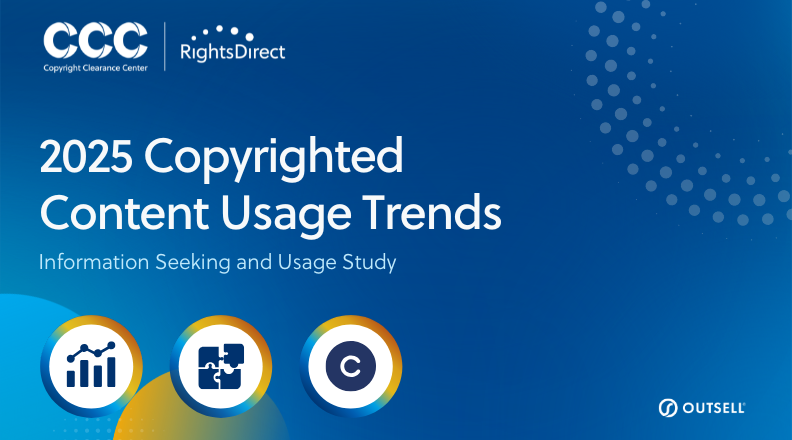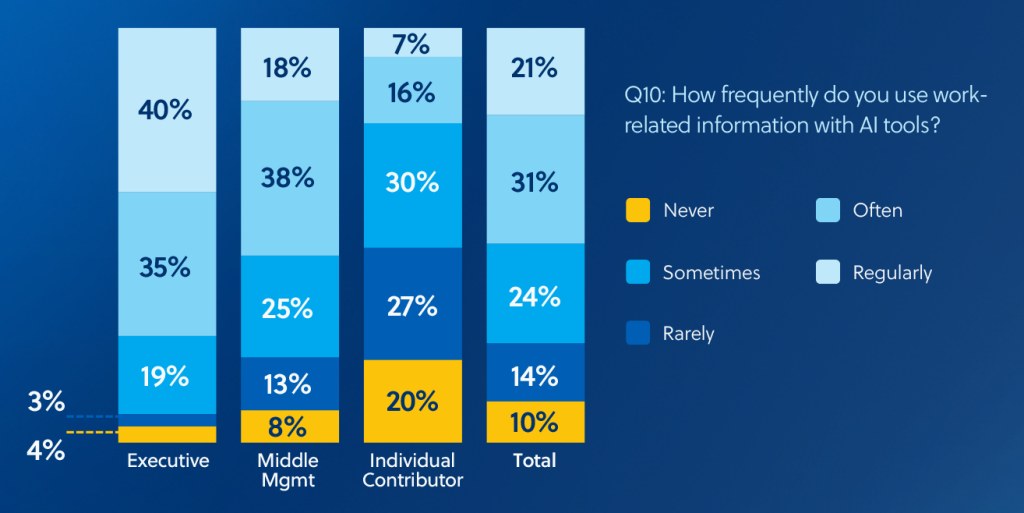Since 2007, CCC has partnered with Outsell, Inc., provider of must-have intelligence to data, information, and analytics businesses worldwide, to conduct independent research and analysis into content consumption in the workplace by professionals across industries.
The following is an excerpt from the ebook, “2025 Copyrighted Content Usage Trends,” which draws on data from the 2025 Information Seeking and Usage Study to offer insights into how employees think about, use, and share copyrighted content today, including with AI tools.
The full ebook can be found here.
Importance of Published Content
Published content is at the heart of innovation. The ease with which teams can access and share published information, such as news, journal articles, research reports, and more, can influence the pace at which organizations and their teams drive innovation and deliver products and services to the market. Executives report that they depend on an average of 13 critical-to-job print or digital publications; middle managers (7.7) and individual contributors (8.1) rely on fewer. Of the publications accessed, executives report using 8.6 publications per week compared with middle managers 11.5) and individual contributors (7.4).
Across the 14 verticals* surveyed, employees at all job levels rely on an average of 9 print or digital publications they deem critical to their innovative research and work. At the high end, employees in Electric and Gas Utilities (17.6), Computers and Electronics (13), Transportation and Automotive (12.2), Life Sciences (10.7), Oil and Gas Extraction (10.3), and Food/Beverage and Agriculture (10) rely on even more.
The Velocity of Content Is Shifting
The velocity of content is a measure of how quickly externally published information flows inside of an organization. It is calculated by multiplying the data points in this survey for the frequency of sharing, the number of people with whom information is shared, and the percentage of that information that comes from external sources.
The velocity of content remains high. Since the 2023 survey, there is a notable increase in both the number of people with whom published content is shared per week and the number of people with whom that information is shared in all verticals. On average, employees reported that 48% of the information they shared is from externally published sources and 52% is internal to their organization.
Impact of AI Tools
With reported AI adoption rates of more than 50% across industries, AI is transforming how users interact with content.
Within organizations, executives are ahead of the curve with 75% using AI frequently, reflecting their need to consume information more quickly in less time. This data also suggests that executives are at greater risk when it comes to compliance, despite claiming to have higher copyright awareness.
As organizations increasingly leverage AI for assistance with conducting research, analyzing data, summarizing articles and content sets, and performing other administrative tasks, a key challenge is confirming that the content used is properly licensed and the associated rights are respected. Only 62% of respondents realize that their organization’s copyright policy applies to using third-party information with AI tools, emphasizing the importance of a robust, compliant, and efficient approach to managing copyright.
Collaboration Platforms Emerging as Preferred Channel for Content Sharing
The ability to work on digital platforms remains crucial. While email attachments remain the most commonly reported way to share information with colleagues, collaboration tools have surpassed email as the preferred method of sharing information, highlighting a growing reliance on dynamic, team-focused platforms that streamline information sharing in real time.
Downloading content through any tool makes a new copy of that content — and copying often requires permission. With the rise in the use of collaboration tools, more people may be downloading content from those tools, creating new potential instances of unlicensed sharing.
* Verticals Surveyed:
- Aerospace & Defense
- Chemicals & Plastics
- Computers & Electronic Components
- Consulting & Professional Services
- Electric & Gas Utilities
- Finance/Insurance
- Food/Beverage & Agriculture
- Hospitals & Healthcare Providers
- Law Firms
- Life Sciences
- Oil & Gas Extraction
- Software & Systems
- Transportation & Automotive
- Wholesale/Retail
Keep Learning
- 2025 Copyrighted Content Usage Trends resource page
- AI, Copyright & Licensing community page
- The Heart of the Matter: Copyright, AI Training, and LLMs – Executive Summary
- An Inside Look at T. Rowe Price’s Approach to Copyright & Responsible AI


